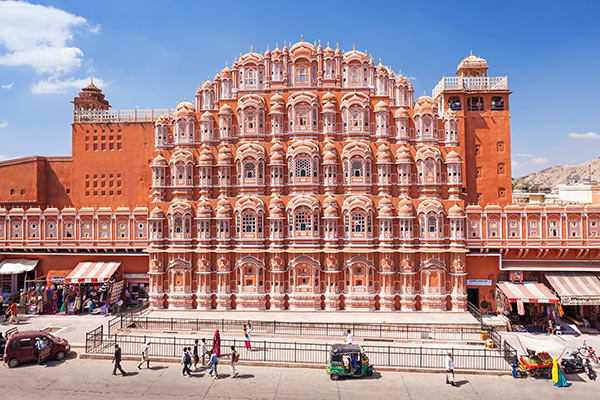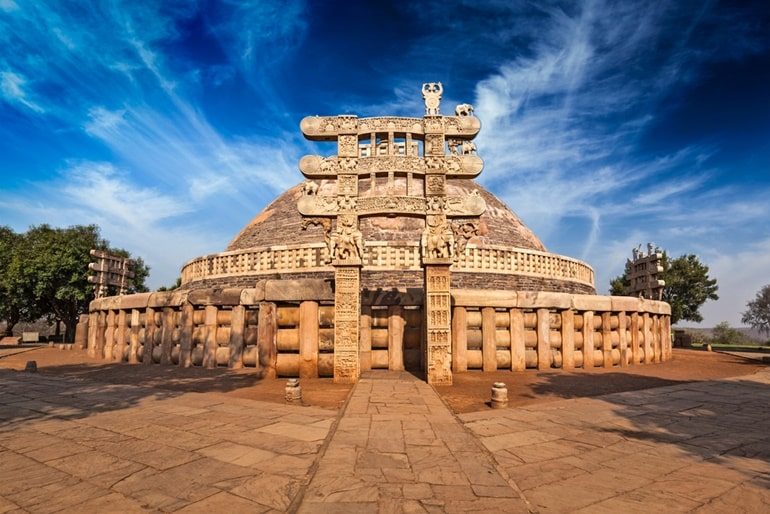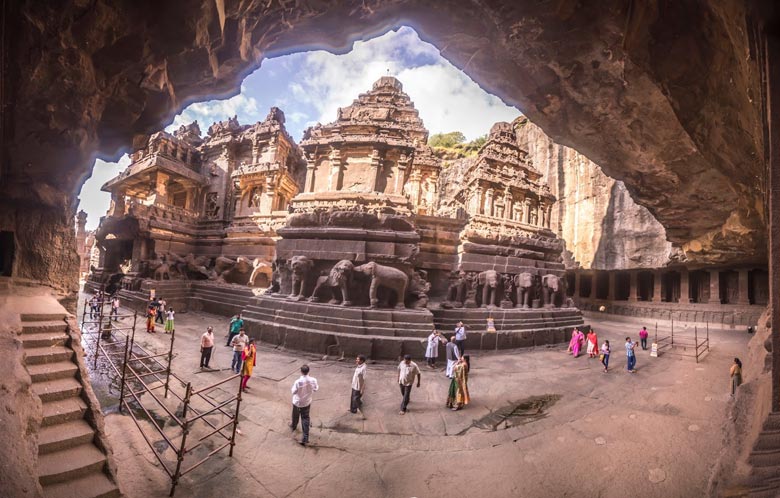
There is lot of Historical Places in India. This country has been ruled by different people for more than a century. With every new ruler came new historical places. Every Kingdom tried to leave a time stamp on the calendar by attempting to build something new, something big, something that could prove their prowess to the world. But not all succeeded in doing this; nevertheless all these attempts are what India is proud of today. There is an unending list of Indian historical places included in the UNESCO World Heritage Site. Today according to some international reports India holds the 65th position among the 144 nations in tourism department. Better air connectivity, easy land transportation means and cheap accommodation is boosting India’s tourism.
In this article you will find information about some highly visited historical place in India.
1.Taj Mahal
TajMahal situated in Agra was built in the year 1653 by a Mughal emperor named Shah Jahan in memory of his departed wife MumtazMahal. This is why TajMahal is also known as a “Mecca of love”. Its construction took 22,000 people work day and night for a period of 22 years. The building is made entirely of white marble with precious stones engraved on it. The Taj Mahal is one of the Seven Wonders of the World; its mesmerizing beauty cannot be compared to any other structure. Every year thousands of tourists visit India just to have a glance of this standing beauty.
TajMahal comprises of the main gateway, a garden, mosque, guest house and palatial buildings. Agra also has a airport to help tourist reach directly to their destination. It is a military airbase located at a distance of 12.5 kilometres from the main city. Agra can also be reached via the capital city of India by train or by road; multiple options at different time are available.
Facts to know about Taj Mahal
- Shah Jahan planned to build another Mahal in black marble on the other side of the river but the war with his sons interrupted his thoughts.
- TajMahal has a pinkish look at dawn, milky white in the evening and golden in the dark. The change in colour resembles the changing mood of a female.
- TajMahal is 171 meters tall.
- The four pillars standing around TajMahal are slightly tilted outwards to prevent it from falling on the Mahal in case of an earthquake.
- Britishers ripped off precious stone from the walls of TajMahal in 1857.
- Shah Jahan ordered to chop every workers hand so that it couldn’t be replicated.
- Many historians believe that TajMahal is a Hindu monument and Shah Jahan acquired it from its previous owner Hindu king Jai Singh.
- It is the symbol of love and care that Shah Jahan had for his wife.
2.Hawa Mahal

HawaMahal is built by Maharaja SawaiPratap Singh in the pink city of India- Jaipur. Built in 1799 HawaMahal is a masterpiece of Rajputana architecture. It was fabricated to let the royal ladies have a view of the colourful processions taking place on the busy streets of old Jaipur. Lal Chand Ustad – a famous architect of the forgotten era designed this Indian historical place and the best thing about this particular design is its crown like shape built in relation to Lord Krishna’s head.
The Hawa Mahal is made of pink and red sandstone with a layer of white quick lime. It has a peculiar honey-combed architecture and is a 5 storey building. The presence of 953 windows makes it look like a giant screen from outside. Every small casement is attached with a balcony and arched ceiling. These windows allow sufficient air flow to combat the scorching sun of Jaipur. Reaching Jaipur is not a Hercules task, the city has its own airport and any individual can route you to this Mahal from the port.
Facts to know about Hawa Mahal
- It is the planets tallest construction without a foundation.
- It is curved and inclined at an angle of 87 degrees.
- There is no front entrance to the building.
- There are no stairs in the building; only ramps are used to climb to higher levels.
3.Konark Sun Temple
The sun temple at Konark in Odisha was built in the 13th century by King Narasimhadeva I. It was built along the river Chandrabhanga. The king belonged to Eastern Ganga Dyansty. It has the shape of a chariot with twelve pairs of carved stone wheels, walls and pillars. Some of these wheels are three meters wide is and is driven by seven pairs of stallion. The direction of the seven horses is towards east, the direction where sun rises and seven represents the number of days in a week. Twelve symbolises all the months of a year and eight spoke in every wheel implies to the eight different stages in woman’s astronomical day. The temple follows Kalinga architecture and is oriented in such a manner that the principal entrance is struck by the initial rays of daybreak. Khondalite rocks have been used for its construction. There is a pair of lions present in the temple, one at each side of the entrance. The lion can be seen sitting on an elephant that is crushing a human body. This imagery has an in depth meaning applicable to the digital world also. Here elephant signifies wealth and lion signifies pride; both pride and wealth are flaws that can crush Homo sapiens (human beings).
Facts to know about Konark Sun Temple
- Many erotic sex positions from Kamasutra has also been carved on the surface of the temple.
- The original temple had sanctum sanctorum whose height was 229 feet equivalent to 70 metres. The audience room or hall is 30 metres in height.
- There is a belief that the temple possessed great power which derived from the two forceful magnets in the tower. These magnets supposedly permitted the kings throne float above ground level.
- Black pagoda is the name mariners used to refer to this temple; reason being the recurrent crushing of ships along the sea shore.
- The sanctorum cannot be witnessed in present day but the dance and dining hall of the temple survived.
- There are many theories associated with the collapse of the sanctorum but no concrete conclusion is made till date; some say it was the poor foundation while some believe that the temple wasn’t even completed properly.
4.Sanchi Stupa

One such Stupa is positioned in Sanchi belonging to the state of Madhya Pradesh, India. It is among the most preserved Stupa. Stupa has an umbrella like upper design with multiple disks encircled by railings. The three disks symbolize Buddha, the law and monastic order which are considered to be the jewels of Buddhism. The nearest airport to Sanchi is in Bhopal, the capital city of Madhya Pradesh. You can cover the remaining 46 kilometres in train, bus or cab depending on your mood and budget.
Facts to know about Sanchi Stupa
- There is no entrance to the Stupa; if you wish to pray to Buddha you can only traverse the circular path around it.
- Sanchi Stupa is home to the shrine of a Buddhist teacher from another Stupa.
- Stupa earlier model was made of bricks and mud which was later encased.
- Stupa tip is at a vertical distance of 16.46 meters from ground level.
- ‘Toranas’ are four gateways surrounding Stupa and are carved.
- Mauryan polish layer survived the slams of time and can still be spotted in the carvings at Sanchi Stupa.
- Sanchi Stupa has been renovated several times in different eras; the last of which was during Gupta’s rule.
- The national emblem of India was taken up from the Ashoka pillar.
5.Victoria Memorial

Victoria Memorial is a huge building dedicated to the remembrance of Queen Victoria and is covered in white marble. The structure stands on a ground beside the bank of river Hoogly in Kolkata (Calcutta) in the state of West Bengal, India. Queen Victoria touched room temperature in January 1901 following which the then Viceroy of India Lord Curzon commanded construction of this gigantic hall. Don’t ever miss any opportunity to visit the hall and observe the statues of Learning, Architecture, Art, Motherhood, Justice, Prudence and Charity existing in gardens of the hall.
The Memorial occupies sixty-four acres on Kolkata’s land measuring 338 feet X 228 feet and has an approximate height of 184 feet. Architecture of this hall is in close resemblance to that of TajMahal located in Agra; from the dome structure to the design of Chatris and terrace. Kolkata is one of the metro cities in India; therefore multiple options are available to reach this destination. Kolkata has its own airport and many other historical places apart from Victoria Memorial hall are worth visiting in one life time. Uncountable number of tourists visits this place whenever they are in or around Calcutta. Today Victoria Memorial is the pride of that region and is one of the most visited destinations of Indian historical places.
Facts to know about Victoria Memorial
- Construction of this memorial hall started in 1906 in Calcutta when it was the capital of India but by the time the structure was open to public, King
- George V had shifted the capital from Calcutta to New Delhi.
- Money for constructing this mammoth came from British Government of London, independent and other states under British Raj.
- This project required investment of 10 million rupees at that time.
6.Ajanta And Ellora Caves

Ellora and Ajanta caves can undoubtedly be declared as the crown jewel among all Indian historical places. The two caves are known by archaeologists present throughout this planet for it is made using hands only. John Smith, a British officer who was on a hunting voyage accidently unearthed these caves in 1819. Since then it has been a major tourist attraction and people from all over the globe visit these caves. The wow factor is the presence of brilliant paintings and sculptures. The caves are near Aurangabad- a city in Maharashtra, India. Work in these caves can be linked to Jainism, Buddhism and Hinduism; considerable part of which is Buddhism. It is also listed as a religious destination.
About Ajanta Caves
Ajanta is a collection of 29 caves and is filled with different sculptures and paintings. Chaityas and Viharas present in these caves imply that it was the centre of Buddhist knowledge; Buddhist rituals were practiced in them. The carvings are as if the whole story of Buddhism is engraved on them, at least for the long period between 200 BC and 650 AD.
Simple tools like hammer and chisel were used to build the figures and are appreciated by people of the twenty-first century also. This is a proof to the excellent thinking and craftsmanship of our forefathers. Lord Buddha’s sculptures and images are very well protected in Ajanta caves. There is some Greek, Chinese and Roman style used in the inscriptions; Indian being the dominating style.
About Ellora Caves
Compared to Ajanta caves there are 5 extra caves in Ellora; devoted evenly to the gods of Jain, Hindu and Buddhists. Twelve of these caves represent Buddhist tradition; five personify Jain culture and the remaining seventeen are devoted to Hinduism. Largest monolithic structure of the world is in cave 16 dedicated to Shiva and is the most popular among these caves.
Content Source:- https://www.travelnthrill.com/
Thank you, for reading my blog. Hope you will like it.
Please leave your valuable comment and share it.
Content Source:- https://www.travelnthrill.com/


0 Comments